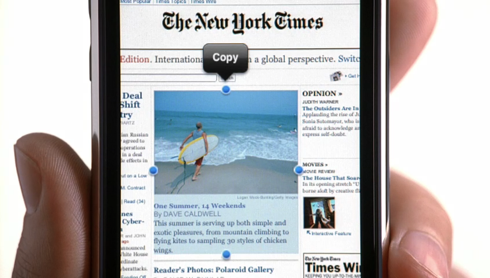
I don’t own an iPhone, but I play with one on TV. Apple’s widely praised ads, with their relentless focus on the phone itself, have demonstrated the magic of its mobile device even to those of us who cling to our BlackBerries. Lately, I’ve been made aware that the iPhone can shoot and edit video and level a bookshelf.
But most of all, I know how good the New York Times website looks on the iPhone. Since the first TV spots in 2007, Apple has chosen to demonstrate its mobile browser almost exclusively with NYTimes.com. And that makes the Times very happy indeed.
“The Times recently secured prime product placement in conjunction with the release of Apple’s iPhone 3G S,” crowed Scott Heekin-Canedy, who runs the business side at the Times, in a memo to staffers last week. He listed all of the newspaper’s cameos in Apple’s latest marketing campaign, including: the homepage in a spot demonstrating copy-and-paste, Inauguration Day coverage in the guided tour, and the Times iPhone app in Apple’s “staff picks.” He also noted, “We’re used to illustrate the iPhone as a ‘breakthrough Internet device’ and ‘it works like no other phone: multi-touch.'”
Not long ago, Apple sought to improve its own brand by linking the PowerBook with Mission: Impossible and, more recently, landing its products on The Office, 24, and seemingly all of HBO’s programming short of Deadwood. Legacy newspapers, meanwhile, have generally relied on history, name recognition, and those boxes on every downtown street corner as their most powerful marketing tools.
But the iPhone campaign demonstrates how in a digital age, device makers from Apple to Amazon enjoy immense power to which news organizations may be unavoidably beholden. In his memo, Heekin-Canedy explained, “Not only does this raise awareness of our iPhone app, but it also extends our innovation message through close alignment with one of today’s top brands.”
I asked Diane McNulty, a spokeswoman for the Times, if the newspaper has paid for its product placement in Apple’s marketing. She replied, “Actually, they asked us if they could feature NYTimes.com in their promotion — and we were happy to oblige.” Apple has run several huge, animated ads on the Times homepage since last year.
On laptop and desktop computers, consumers can rely on a diversity of news and information sources — a diversity that undermines the notion of a newspaper site as a reader’s single source of news. But the mobile space — with its emphasis on individual news-organization-built applications — may present a better opportunity for some news sites to serve as one-stop shops of information for readers checking the news in spare moments. And in that sense, the Times has much to gain from its association with the iPhone’s browser.
Other news organizations could attempt analogous marketing relationships with the Amazon’s Kindle, RIM’s BlackBerry, Palm’s Pre, TechCrunch’s forthcoming CrunchPad, and so on. Instead, companies like Hearst are attempting to produce their own mobile devices. That may work, but associating with an already strong brand seems more reliable than completely reinventing your own.